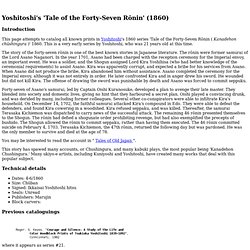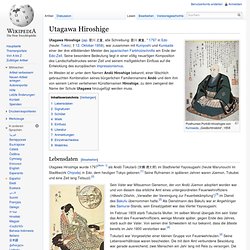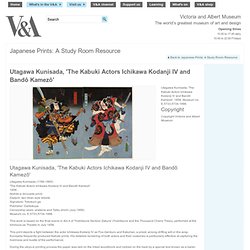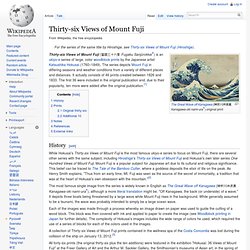

Kuroda Ukinaga, Japanese actor - Utagawa Kuniyoshi. Utamaro's books in the Fitzwilliam Museum, Cambridge. Japanese Prints Utagawa kuniyoshi and Kunisada. The Lavenberg Collection of Japanese Prints. Fuji Arts Japanese Prints - Japanese Woodblock Prints and Decorative Arts. Utagawa Kunisada (Toyokuni III) - Project. Utagawa Hiroshige II (1826-1869) Catalogue Raisonné. Tsukioka Yoshitoshi (1839-1892) Catalogue Raisonné. S 'Tale of the Forty-Seven Rōnin'
Introduction This page attempts to catalog all known prints in Yoshitoshi's 1860 series 'Tale of the Forty-Seven Rōnin ( Kanadehon chūshingura )' 1860.

This is a very early series by Yoshitoshi, who was 21 years old at this time. The story of the forty-seven rōnin is one of the best known stories in Japanese literature. The rōnin were former samurai of the Lord Asano Naganori. In the year 1701, Asano had been charged with the reception ceremony for the Imperial envoy, an important event. Forty-seven of Asano's samurai, led by Captain Oishi Kuranosuke, developed a plan to avenge their late master. You may be interested to read the account in " Tales of Old Japan ". This story has spawed many accounts, or Chushingura, and many kabuki plays, the most popular being 'Kanadehon Chushingura.' Technical details Dates: 4-6/1860Size: ChūbanSigned: Ikkaisai Yoshitoshi hitsuSeals: UnreadPublishers: MarujinBlock carvers: Previous cataloguings Roger. Where it appears as series #21. Ando Hiroshige. Hiroshige. Posthumes Porträt Hiroshiges von Kunisada, „Gedächtnisbild“, 1858 Utagawa Hiroshige (jap.

歌川 広重, alte Schreibung: 歌川 廣重, * 1797 in Edo (heute: Tokio); † 12. Oktober 1858), war zusammen mit Kuniyoshi und Kunisada einer der drei stilbildenden Meister des japanischen Farbholzschnitts am Ende der Edo-Zeit. Seine besondere Bedeutung liegt in einer völlig neuartigen Komposition des Landschaftsdruckes seiner Zeit und seinem maßgeblichen Einfluss auf die Entwicklung des europäischen Impressionismus. Im Westen ist er unter dem Namen Andō Hiroshige bekannt, einer fälschlich gebrauchten Kombination seines bürgerlichen Familiennamens Andō und dem ihm von seinem Lehrer verliehenen Künstlernamen Hiroshige, zu dem zwingend der Name der Schule Utagawa hinzugefügt werden muss. Lebensdaten[Bearbeiten] Hiroshige, bijin, Serie „Acht Ansichten - Frauen und Landschaften im Vergleich“, Anfang 1820er Im Februar 1809 starb Tokutarōs Mutter. Die Pflichten eines Feuerwehroffiziers in Edo zu Beginn des 19.
The Fifty-three Stations of the Tōkaidō. The Tōkaidō road, linking the shōgun's capital, Edo, to the imperial one, Kyōto, was the main travel and transport artery of old Japan.

It is also the most important of the "Five Roads", the five major roads of Japan (Gokaidō), created or developed during the Edo era to further strengthen the control of the central shogunate administration over the whole country. Even though the Hōeidō edition is by far the best known, The Fifty-Three Stations of the Tōkaidō was such a popular subject that it led Hiroshige to create some 30 different series of woodcut prints on it, all very different one from the other by their size (ōban or chuban), their designs or even their number (some series include just a few prints).
Kuniyoshi Project. Utagawa Kunisada, 'The Kabuki Actors Ichikawa Kodanji IV and Bandô Kamezô' Utagawa Kunisada (1786-1865)'The Kabuki Actors Ichikawa Kodanji IV and Bandô Kamezô'1856Nishiki-e (brocade print)Diptych, two ôban-size sheetsSignature: Tokokuni gaPublisher: DaikokuyaCensorship seals: aratame and Tatsu shichi (July 1856)Museum no.

E.5733,5734-1886 This work is based on the final scene in Act 4 of 'Yoshitsune Senbon Zakura' (Yoshitsune and the Thousand Cherry Trees), performed at the Ichimura-za Theatre in July 1856. This print depicts a fight between the actor Ichikawa Kodanji IV as Fox-Genkuro and Kakuhan, a priest, among drifting will-o'-the-wisp. Kunisada frequently produced Kabuki prints. His detailed rendering of both actors and their costumes is particularly effective at capturing the liveliness and bustle of the performance. 没後150年 歌川国芳展[ Kuniyoshi: Spectacular Ukiyo-e Imagination ] Utagawa Kuniyoshi. Thirty-six Views of Mount Fuji.
Thirty-six Views of Mount Fuji (富嶽三十六景, Fugaku Sanjūrokkei?)

Is an ukiyo-e series of large, color woodblock prints by the Japanese artist Katsushika Hokusai (1760–1849). The series depicts Mount Fuji in differing seasons and weather conditions from a variety of different places and distances. It actually consists of 46 prints created between 1826 and 1833. The first 36 were included in the original publication and, due to their popularity, ten more were added after the original publication.[1] History[edit] The most famous single image from the series is widely known in English as The Great Wave off Kanagawa (神奈川沖浪裏, Kanagawa-oki nami-ura?) Each of the images was made through a process whereby an image drawn on paper was used to guide the cutting of a wood block. OGATA GEKKO. Tsukioka Yoshitoshi (1839-1892) Catalogue Raisonné. 月岡芳年 Yoshitoshi. The Floating World of Ukiyo-E (Library of Congress Exhibition)
浮世絵美術館へようこそ|名古屋テレビ浮世絵美術館 - 名古屋テレビ 【メ~テレ】 Viewing Japanese Prints: Woodblock Prints, Ukiyo-e, Sosaku Hanga, Shin Hanga, Kindai Hanga. A Guide to the Ukiyo-e Sites of the Internet.